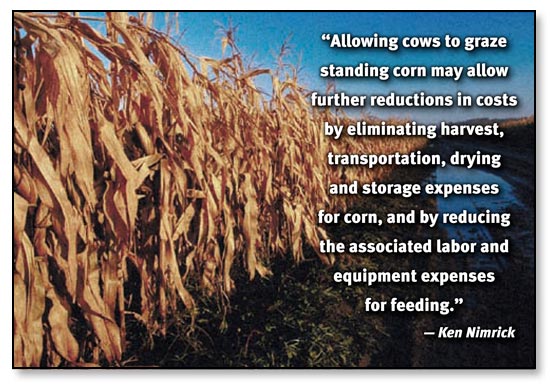HEALTH & NUTRITION...
An Economic Winter Alternative
 A seven-year field demonstration study in Illinois confirms wintering cows on limit-fed, strip-grazed standing corn supplemented with small amounts of corn gluten feed (CGF) can be an economic alternative to other winter feeding programs.
A seven-year field demonstration study in Illinois confirms wintering cows on limit-fed, strip-grazed standing corn supplemented with small amounts of corn gluten feed (CGF) can be an economic alternative to other winter feeding programs.
"Overall, the system is quite cost-effective. Cows quickly adapt to the system and perform well," reports Ken Nimrick, Western Illinois University beef cattle professor. Read more.
Evaluating Wet Distillers' as Feed
There may be no such thing as a free lunch, but a cheap meal is easy to come by — especially if you use the right ingredients.
With ethanol plants popping up across the nation, many cattle producers are weighing the effects of substituting a common ethanol byproduct for more costly traditional feed ingredients such as corn, soybean meal, urea and mineral supplements.
The byproduct, called "wet distillers' grains with solubles," or WDGS, has potentially significant economic benefits. WDGS typically costs about 10% less than corn when used as livestock feed.
ARS scientists at the U.S. Meat Animal Research Center (USMARC) in Clay Center, Neb., are investigating the effects of feeding WDGS to cattle. The scientists carried out a comprehensive study on the influence of diets including WDGS in four areas: feedlot performance, energy utilization efficiency, postharvest meat characteristics, and cattle manure emissions. For these studies the cattle were fed diets containing 0%, 20%, 40% or 60% WDGS.
Research results show that WDGS, in moderation, may offer an inexpensive alternative to traditional feed ingredients. Read more.
Nebraska Officials Ask Hunters to Watch for TB
As deer hunting season gets under way, the Nebraska Game and Parks Commission is asking hunters for their assistance in monitoring the deer population for tuberculosis (TB).
According to the commission, within the past year bovine TB was discovered at a facility with a captive elk and deer herd in northern Knox County. There was also a finding of bovine TB in a beef herd in Rock County.
The Nebraska Department of Agriculture continues to test cattle for bovine TB in north-central Nebraska. To date, 11,800 head have been tested with no positive cases.
TB-infected deer may have tan or yellow lumps lining the chest cavity; in the lung tissue; or in the lymph nodes of the cheek, head and neck. Any hunter who observes these signs when field-dressing a deer should contact the nearest commission office.
AVMA Disputes Pew Study on Antibiotics in Feed
The American Veterinary Medical Association (AVMA), the nation's largest veterinary association, has issued to Congress a scientific response that disputes several of the findings and recommendations made in a report released last year by the Pew Commission on Industrial Farm Animal Production.
In a letter sent to members of the U.S. House of Representatives and the U.S. Senate, Ron DeHaven, AVMA CEO, expressed concerns about the Pew Commission's report and urged members to vote against H.R. 1549 and S. 619, the "Preservation of Antibiotics for Medical Treatment Act (PAMTA)" as they are written.
The AVMA questioned the Pew Commission's methods and outcomes, citing bias in its process for gaining technical expertise and significant shortfalls in how it would execute a new plan or program. AVMA also criticized the Pew Commission's recommendations for highly restrictive bans on antibiotic use, saying the restrictions have not been proven beneficial to public health. "When Denmark and the Netherlands made an attempt to implement less restrictive bans on antibiotics than those recommended by Pew, they found that even a small decrease in antibiotic use severely diminished animal health and welfare without significantly improving human health," the letter stated.
The full AVMA report, as well as a special podcast featuring an interview with DeHaven on the AVMA's response to the Pew Commission's study, is available here.

Grant Dewell
Vet Link
Establishing a vaccination and
health management schedule
Grant Dewell, Iowa State University (ISU) beef Extension veterinarian, suggests producers consider their vaccination program prior to weaning. "Ideally, its best to vaccinate your calves prior to weaning so you're not compounding stress of weaning with your vaccination program," Dewell says.
He suggests vaccinating two to four weeks prior to weaning so the calf's immune system has a chance to respond and protect it from potential viruses and bacteria that they'll experience after weaning. Click here to hear Dewell's suggestions.
Salvaging Soybeans as Hay and Silage
Late-planted soybeans that don't mature before the fall frost can be salvaged as hay or silage, says Bruce Anderson, University of Nebraska-Lincoln (UNL) Extension forage specialist. He says soybean hay and silage can have feeding values very similar to alfalfa, at least when they're made right.
"Start by harvesting soybean forage no later than when leaves start to turn yellow, before they drop off. It's especially important to harvest before a freeze to prevent rapid leaf loss," he says.
Soybean hay is challenging to make, as the leaves dry quickly and then become crumbly if raked, while the stems are quite woody and dry slowly.
Be sure to condition or crimp the hay to hasten stem dry down, Anderson advises, and avoid raking if at all possible.
"Soybean leaves crumble easily when dry, which will cause some yield loss and much lower feed value. If you must rake, like if you need to put several windrows together for baling, do it within one day of cutting," he says.
Making good soy silage is less risky, if you have silage equipment and do it right.
"I prefer mixing chopped soybeans with corn or sorghum as they're being ensiled, but that's not always possible. For straight soy silage, first get a good, clean chop. Uniformly add a silage inoculant designed for legumes like alfalfa. In addition, add about 1 bushel of rolled corn or 50 pounds of molasses to each ton of wet silage to aid fermentation. And pack soy silage especially well," Anderson says.
N.D. Reports First Case of Anthrax
Cattle have tested positive for anthrax in southwestern North Dakota, the first case in the state this year, according to The Associated Press (AP).
State Veterinarian Susan Keller says the case was reported along the Hettinger-Slope county line. She says it's the first confirmed case in that region in several years, AP reports.
Anthrax usually appears in very wet or very dry conditions, when dormant bacteria spores in the soil are disturbed. Animals that consume the spores are exposed to the disease.
Keller says ranchers who find dead livestock should consult their veterinarians before disposing of the carcasses.
Animal Health Corridor Takes Shape
Rep. Dennis Moore (D-Kan.) and Rep. Lynn Jenkins (R-Kan.) announced Sept. 15 the passage of a resolution, H.Res. 317, recognizing the region from Manhattan, Kan., to Columbia, Mo., as the Kansas City Animal Health Corridor. The resolution passed the House by a vote of 312-108-1.
“This area provides not only scientific innovation in animal sciences, but also the foundation for long-term economic growth in Kansas and Missouri. The biosciences industry will continue to be an academic and technological leader in both states for years to come,” Rep. Moore said.
The resolution relates to construction of the National Bio and Agro-Defense Facility (NBAF). The NBAF, which will be located in Manhattan, Kan., is expected to provide a significant economic boost to the region. If the Senate appropriates the anticipated $36 million budget, construction for the facility will likely begin in June 2010.
Cattle Diseases: Common Conditions/Terms
Click here for a list of common conditions and terms related to beef cattle diseases, such as anaplasmosis, brucellosis, BVD, E. coli, IBR and others.
[Click here to go to the top of the page.]




